Gaspi has an obsession with volcanoes and anything that resembles them. So when he came up with the idea of going to Guatemala at the end of last year to descend three active volcanoes - Pacaya, Acatenango, and Fuego - we weren't that surprised. But the word active always makes us feel a bit nervous, but more on that in the documentary... Gaspi put together a crew of identical madmen. Ladis Zeman filmed everything around doesn't matter the danger, Míla Štáfek was behind the camera, and Honza Dvořák completed the crew as part of the Sportin.art project. The time for the adventure was set for January. Find out how it went in Guatemala and when and where the documentary will premiere in the following interview.
ONLINE premiere: Sunday 26.3. at 19:00, Horsefeathers.eu/over-the-edge
Global online premiere of the documentary here 👉 horsefeathers.eu/over-the-edge
OFFLINE premiere: Thursday 23.3. at 19:00, Horsefeathers store, Prague
Entry by ticket only. Limited number of tickets. Book yours for free here 👉 horsefeathers.eu/over-the-edge
In your new documentary, called Over The Edge, you went to Guatemala and ride down three active volcanoes. And it wasn't the first time you went somewhere just to ride active volcanoes. What fascinates you about them? Why are you looking for active volcanoes?
I don't necessarily only look for active volcanoes, I also look for inactive volcanoes. But those inactive volcanoes are mostly already covered with forest. If it is hundreds, maybe thousands of years since the volcano is no longer active, the flora will become alive again and a forest will grow there. Active volcanoes also attract me due to the fact that they are sometimes easier to get to, than normal mountains with beautiful nature, because they usually fall under national parks or Unesco and it is very difficult to get a permit for that. Most of the time you are not even allowed to ride a bike there. This is not the case with volcanoes. They are active, there are eruptions and after each eruption the nature changes, so there are usually no rules and restrictions. However, I do this at my own risk. But if it is active, we always ask for entry and permission to film.
That's probably because it's assumed that most people won't want to visit active volcanoes, let alone ride bikes there, right?
I think so. For example, I'm still fighting for the Stromboli volcano permit, but at the moment it doesn't look like it's going to work at all. It is still active and a couple of weeks ago two Englishmen climbed there illegally, they caught them and because of that, they threw off the table all applications for entry permits. I think it will take at least a few years before they allow entry there again. Fortunately, I have already been there once, I managed to do it in 2017 together with two 12-year-old boys as part of one project. Etna, one of the largest and most active European accessible volcanoes, is another favorite of mine. Regarding the documentary Over The Edge, my photographer, Milo Štáfek, and I were discussing where we could go as part of our collaboration with HF, and we were captivated by the Fuego volcano, in Guatemala, Central America. Then we added two more volcanoes near it, so we had a clear plan – the triangle of volcanoes in Guatemala.

Why Guatemala? As you said before, you have already rode some European volcanoes, so was it the intention to go somewhere further and find something more exotic?
It can also be said this way, but I was more fascinated by the fact that the volcanoes are again completely different from the ones we have in Europe. They are more violent, more dangerous and evoked such an expedition and adventure in me. Until we stood under them, we didn't know what we were getting into. It was a challenge, as Fuego, for example, is one of the most active volcanoes in the world, erupting on average every 27 minutes. At night, you can watch an incredible huge firework display of hot lava stones on it.
How high were those volcanoes? Did you also need guides there?
The first volcano we went to, Pacaya, is about 2700 m.a.s.l., and we didn't need guides there. It's not that high, but it's awfully dangerous. The weather on it changes rapidly, stones are torn from it, there is no access road. For 9 hours we crawled there on a terribly sharp surface, on which I cutted my pants. We needed guides for Acatenango and Fuego. They are two volcanoes right next to each other that connect somewhere at 3000 m.a.s.l. through a small valley. At 3750 m.a.s.l., we had a base camp where we slept and from there we climbed first to Acatenango and then to Fuego, which is actually the most active volcano and there I managed to get to the dangerous zone, where no one has been on foot yet, not even mentioning the bike.
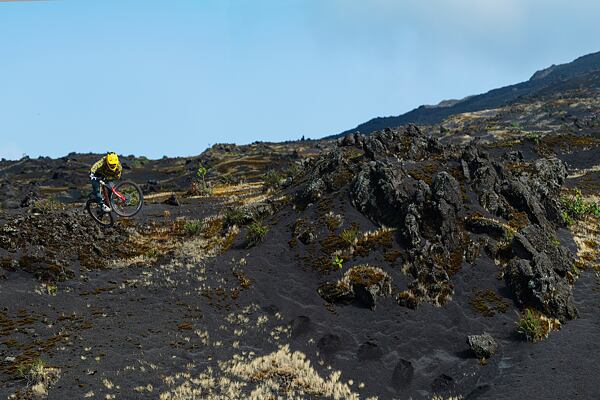
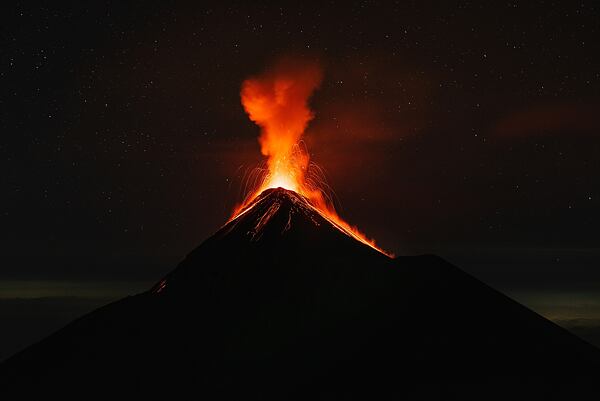
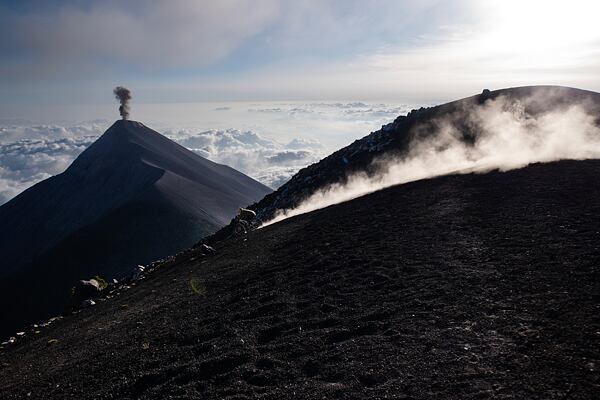
Can you introduce to the crew you went there with?
I went there with my photographer, Míla Štáfek, cameraman Ladis Zeman and Honza Dvořák, who was with us for Sportin.art. He is my friend, who took it upon himself to help us on the trip. I was grateful for that because, for example, he made arrangements when my bike didn't arrive or did a back office work for us, that I didn't have time for. As a part of Sportin.art, Honza combines art with sport and came up with the concept that we bring a bag of ash from each volcano we visit and an Australian artist incorporates it into his works, which are then auctioned off for charity. So there will be some added value in it, which makes me happy. And right in Guatemala, we were joined by one more American, Brandon James, whom we contacted before the flight, when we were looking for someone to help us in Guatemala. Brandon has lived there for 15 years and is active in the cycling world, organizing bike camps, and I will go to Guatemala to help him with one camp in November. So I already know that I will be back there again.
How did it go after the flight? Did you already have everything arranged there, or was it also a bit of a punk?
I can't afford to do anything punk at the moment. The bigger the project, the bigger the team of people involved in it, for which I am responsible. Everything must therefore be resolved in such a way that it is acceptable and safe. It's not just about me anymore. So we had permits for everything, with which the already mentioned Brandon James helped us, we prepared everything about half a year in advance. We dealt with national park permits, as well as official permits to transport a kilo of ash from each volcano, as this is not normally allowed. As for the Fuego volcano, they wrote back to us that we would not be able to do it, because we would pay for it with death, due to the fact that it is terribly active.
So I'm assuming you don't have that material from Fuego, as long as you're alive.
We do have! I scooped it up and then we had a pretty quick evacuation plan. I'm alive, only my helmet was hit with a stone and we brought a bag of ash. I even have a photo of me holding that ash bag with hot rocks flying behind me.
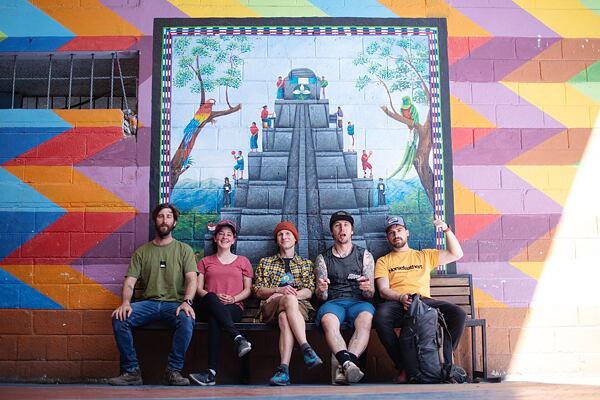
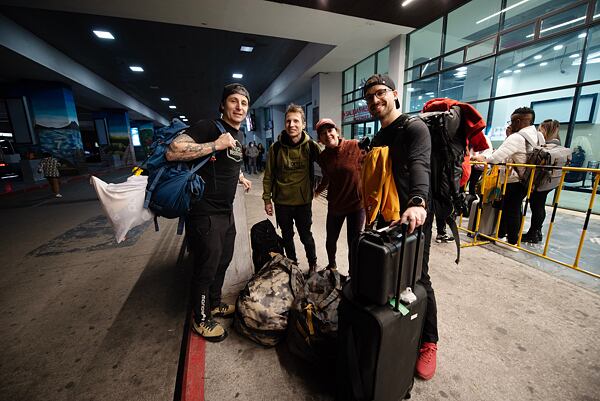
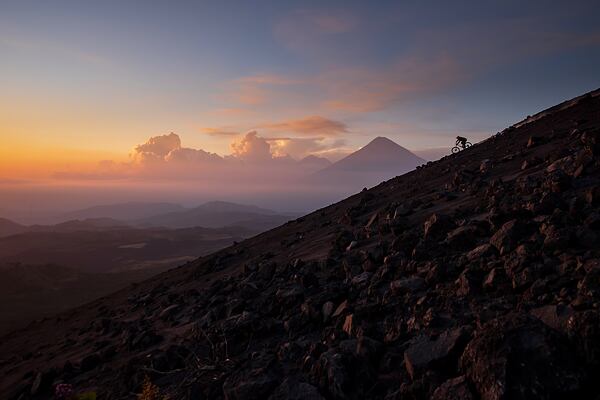
How long did the volcano climbs take?
We didn't climb all the way to the top of Pacaya, because you can't get to the crater, there are no access roads at all, and big rocks fall from there. We climbed there for 9 hours. We climbed Acatenango for about 7 hours with a break at the base camp, where we put our things down, each of us had a 15-20 kg backpack, plus I still had a bike on my back. So it was challenging. Moreover, the temperature there at night was around zero.
Have you experienced altitude sickness?
Of course, we had respiratory problems, when you get short of breath, but as soon as we got to the base camp, to the 3750 m.a.s.l., we calmed down and it was completely fine. I think that the problem only occurs from a height of over 4500 m.a.s.l.
And how did it work with taking the photos and filming on the volcano?
We climbed up, trying to save as much energy as possible that was needed for taking pictures and shooting on the top and for me also for going up and down, because the cameraman needed different shots than the photographer, so I had to go everything more times. We agreed on a clear plan that we wanted to do and we went for it.
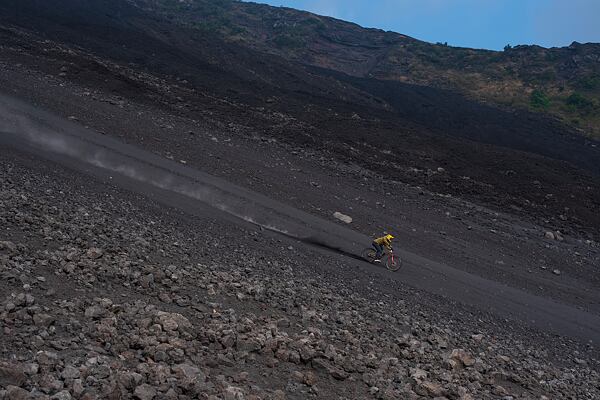
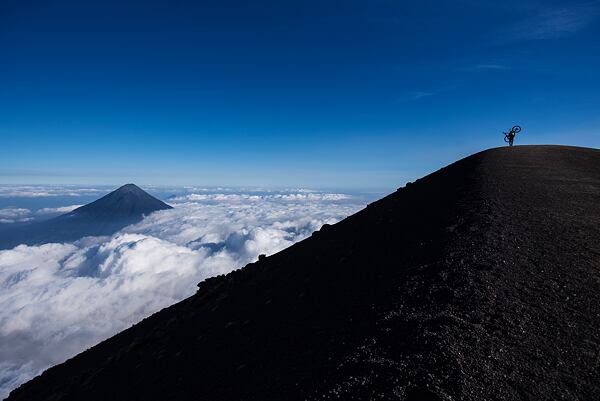
Did you have any preparation before this trip?
Yes, about 2.5 months before the expedition we all started training. For example, I started hiking the hills and training first with hiking poles and adding weight to my backpack, then I put the poles away because I can't lean on anything when I'm carrying a bike on my back.
What is it like to ride down a volcano? What is the terrain like there?
Most of the time it is rideable until the rocks that have fallen there start to get bigger. You need to find a good route where to go. However, there is a layer of soft ash on the surface, on which you can't brake properly, and in addition, we were moving at 45 degree angles, so it was really not fun at times.
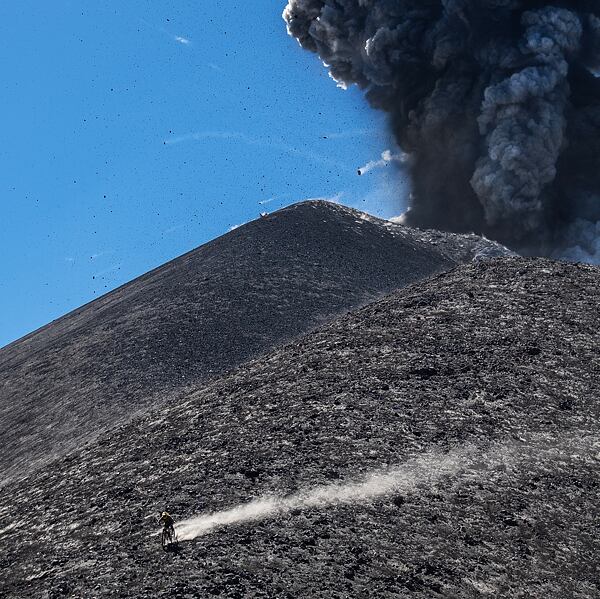
You mentioned in the trailer that, "It's a miracle we made it down safe and sound". What can we imagine behind it?
You will see that in documentary. But the point was, that on Fuego I got into a dead zone, where no one had been before on foot. From the safe zone, Honza was watching me through binoculars with local guides who informed me about the eruptions and whether it was okay to continue or not. If there was a major eruption, I had about 6-10 seconds to turn and escape down. Which I had to do about 6 times. But finally we got to the danger zone, where we wanted to take some more shots, when there were two such big eruptions that stones started falling around us like integrals. When we looked at the sky, there were about 200 rocks falling on us, so we were just guessing if any of them would fall on us or not. The eruption was so strong that it even reached the "safe zone". For example, a red-hot stone with a diameter of about 30 cm fell right next to one of the guides, which he managed to dodge at the last moment. So yeah, we also had some "fun times" in there.
It looks like you had all your guardian angels with you.
Yes, then we thought that we were actually dancing with the Grim Reaper again, but we are really glad that we made it safely and no stone hit us. Although one scratched my helmet, luckily it was only minor. This can be seen in that documentary. I also had a cut on my helmet from it. Ladis was covering himself with a photo backpack and Míla was running and still managed to take pictures of me and the eruption, even though rocks were falling around him. Then we opened a bottle of Guatemalan rum to celebrate that we all were alright.
Were all three volcanoes active while you were riding them?
Two of them were. Pacaya and Fuego were active, but Acatenango was quiet at the time. It was last active about 60-70 years ago, and it alternateswith Fuego in activity about every 200 years. Across the valley, the Fuego sputtered every half an hour.
You already mentioned, that you had a problem with the bike that didn't arrive on time, were there any other complications?
I would not say so, just classic travel problems with accommodation etc. But before leaving for Guatemala, everyone warned me, that it is a very dangerous country, with a high crime rate, that there is a lot of stealing and killing and so on. I didn't encounter anything like that until Brandon took me on his local 60 km trail on the last day of our trip. Along the way, it started to get dark, so we wanted to shorten the way, through a coffee plantation. I went first and suddenly a cocooned guy came running at me from the coffee plantation, holding two huge stones in his hand, which he aimed at my face and said something to me in Spanish. At first I thought he wanted to sell me some minerals, so I told him in Czech that I didn't understand him, to leave me alone. But of course he wanted money. A scuffle ensued, with Brandon communicating with him in Spanish and wrestling with him for a bike. It was our last day, I was already tired and angry, we had been hiking and wandering all day and suddenly before dark a cocooned guy with stones stopped us, so I thought I might not give it any more. I got angry and started shouting all the worst Czech swear words at him, to which he dropped the stones and ran away, completely shaken. So luckily it worked out well.
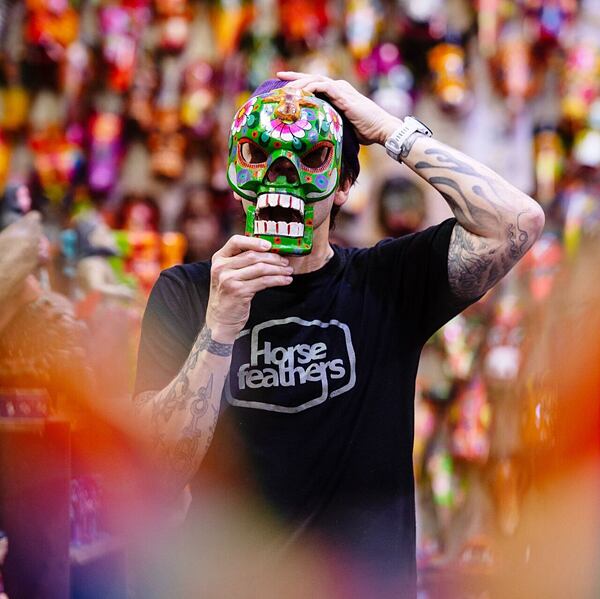
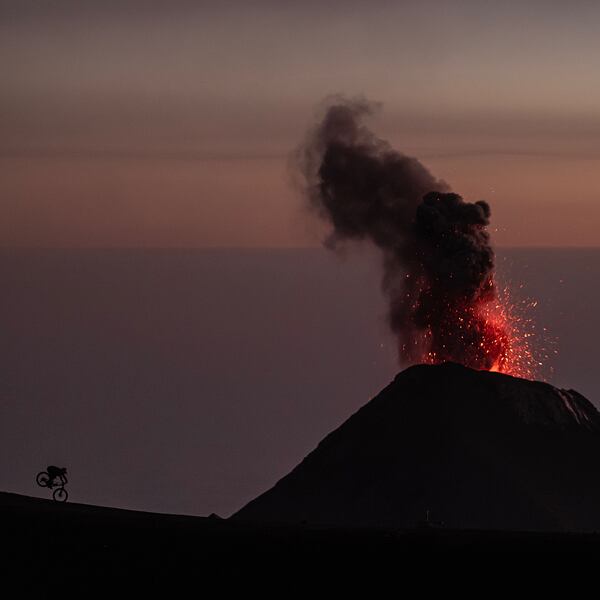
In the end, how would you summarize the whole trip and at the same time invite people to the premiere of the documentary Over The Edge?
Over The Edge will be authentic in a way that we really went over the edge of something we weren't supposed to. Hence the name. In the documentary, you will see how a group of Czech guys went to Guatemala to find active volcanoes. Anyone who hasn't tried it yet doesn't know what energy and vibrations the Earth can produce, what it can spew out and how dangerous it can be. Through the documentary Over The Edge, we will try to bring it closer to you.
ONLINE premiere: Sunday 26.3. at 19:00, Horsefeathers.eu/over-the-edge
Global online premiere of the documentary here 👉 horsefeathers.eu/over-the-edge
OFFLINE premiere: Thursday 23.3. at 19:00, Horsefeathers store, Prague
Entry by ticket only. Limited number of tickets. Book yours for free here 👉 horsefeathers.eu/over-the-edge







